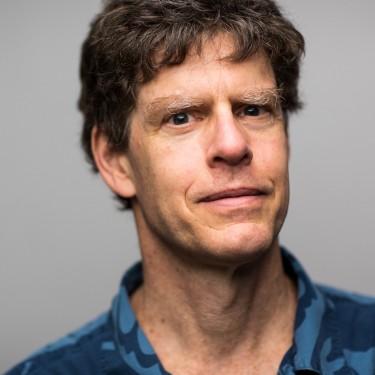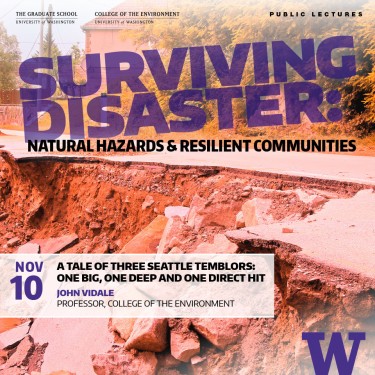
The UW’s John Vidale is a man of many titles—professor of Earth and Space Sciences, director of the Pacific Northwest Seismic Network, and Washington state seismologist. More recently, Vidale helped launch the university’s M9 Project, a cross-disciplinary effort whose goal is to reduce the catastrophic potential effects of a Cascadia megathrust earthquake.
Earlier this year, an article in the New Yorker stirred up panic nationwide over the looming possibility of megaquake along the Cascadia Fault. The writer noted that Seattle and Portland would be impacted greatly, and specifically, that everything west of Interstate 5 would be “toast”. Journalists and concerned individuals wanted to truth check the writer’s claims with a PNW-based earthquake expert—many sought out Vidale’s expertise.
 As part of the Surviving Disaster: Natural Hazards & Resilient Communities series from the College of the Environment, UW Alumni Association, and the UW Graduate School, Vidale will discuss the types of shakes Puget Sound is vulnerable to at a public lecture on Tuesday, November 10 at 7:30 p.m. His talk, “A tale of three Seattle temblors: One big, one deep and one direct hit”, is sold out—but a video link will be available in the days following.
As part of the Surviving Disaster: Natural Hazards & Resilient Communities series from the College of the Environment, UW Alumni Association, and the UW Graduate School, Vidale will discuss the types of shakes Puget Sound is vulnerable to at a public lecture on Tuesday, November 10 at 7:30 p.m. His talk, “A tale of three Seattle temblors: One big, one deep and one direct hit”, is sold out—but a video link will be available in the days following.
In advance of his talk, we caught up with John for a quick Q&A:
What do you hope attendees of your Surviving Disaster lecture walk away with?
“My lecture will be a smattering of recent discoveries, unsolved and perhaps unsolvable problems, and new progress in hazard mitigation. Fighting the rare but destructive attacks of earthquakes is still a work in progress.”
Why is this issue area especially important to focus on in 2015 and beyond?
“Earthquakes are a recurrent fear in areas with as intense geological action as the Pacific Northwest. The shocking tsunamis from the M9 quakes in Japan in 2011 and in Sumatra in 2004, called into view by the recent New Yorker article entitled “The really big one”, have yet again put on the front burner the scenario of building-shaking, inundation, and land sliding in megaquakes in our neighborhood.”
What aspect of this issue rarely gets the attention it deserves?
“We scientists and emergency managers tend to soft pedal the great uncertainty about what will happen in the next dramatic earthquake. When, where, and how severe are far from certain, and the greatest damage is hard to predict. People like specific, actionable advice rather than imprecise muttering about the many dire things that MIGHT happen.”
What aspect of this issue is largely misunderstood by the general public?
“I think that the public tends to overestimate the chance of being hurt in bad earthquakes, but at the same time underestimates the vast cost of damage and business downtime that earthquakes sometimes inflict.”
What’s one thing people might be surprised to learn about you?
“Nothing. Is it surprising that I’m a science nerd? My family consists of a long line of scientists? Maybe that two relatives got Nobel Prizes.”
What are the three most important personality traits for someone in your line of work?
“Intense and sustained interest in enormous piles of picayune details, the ability to avoid mistakes in long chains of logic (or at least find them when experiments run aground), and the irrepressibility to communicate clearly about one’s latest ideas while knowing the most novel and exciting ones probably have mistakes one hasn’t figured out yet.”
What’s something you can’t believe you’re still up against?
“Learning new computer software is endless. It’s probably similar in many jobs. Math, instrument management and data retrieval, data archives, writing, making figures, tracking geographical info, tracking literature, keeping one’s CV, and financial accounting all require sets of programs. The programs change every few years, and even the programming languages. Fortunately the younger scientists are not yet as exasperated, and are willing to tackle the hardest parts.”
What is the most exciting aspect of your current research?
“One thrill is that I don’t know what will happen tomorrow (or late tonight)—whatever shakes will trigger our sensors. Some discoveries take years of curating subtle data, some just require waking up in the morning and looking at the seismometers scattered across the Cascades. It’s hard to imagine a more fun job.”

